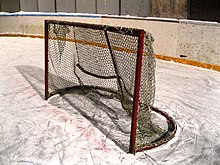
Field hockey is a team sport structured in standard hockey format, in which each team plays with 11 players in total, made up of 10 field players and a goalkeeper. Teams must move a hockey ball around a field by hitting it with a hockey stick towards the rival team's shooting circle and then into the goal. The match is won by the team that scores the most goals. Matches are played on grass, watered turf, artificial turf, or indoor boarded surface. Street hockey is a form of impromptu field hockey typically played by children in Canada, via erecting a net in the street and using the road surface to play.

In many team sports that involve scoring goals, the goalkeeper is a designated player charged with directly preventing the opposing team from scoring by blocking or intercepting opposing shots on goal. Such positions exist in bandy, rink bandy, camogie, association football, Gaelic football, international rules football, floorball, handball, hurling, field hockey, ice hockey, roller hockey, lacrosse, ringette, rinkball, water polo, and shinty, as well as in other sports.
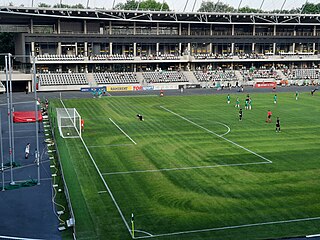
An own goal occurs in sports when a player performs actions that result in the player scoring points for the opposition, such as when a football player puts a ball into their own net.
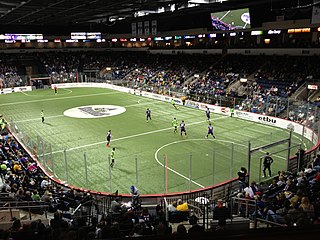
Indoor soccer or arena soccer is a five-a-side or six-a-side version of minifootball, derived from association football and adapted to be played in walled hardcourt indoor arena. Indoor soccer, as it is most often known in the United States and Canada, was originally developed in these two countries as a way to play soccer during the winter months, when snow would make outdoor play difficult. In those countries, gymnasiums are adapted for indoor soccer play. In other countries the game is played in either indoor or outdoor arenas surrounded by walls, and is referred to by different names.

In ice hockey, a goal is scored when the puck entirely crosses the goal line between the two goal posts and below the goal crossbar. A goal awards one point to the team attacking the goal scored upon, regardless of which team the player who actually deflected the puck into the goal belongs to. Typically, a player on the team attempting to score shoots the puck with their stick towards the goal net opening, and a player on the opposing team called a goaltender tries to block the shot to prevent a goal from being scored against their team.
The Field Game is one of two codes of football devised and played at Eton College. The other is the Eton Wall Game. The game is like association football in some ways – the ball is round, but one size smaller than a standard football, and may not be handled – but the off-side rules – known as 'sneaking' – are more in keeping with rugby. There is also a small scrum or "Bully" of either six or seven a side. Goals can be scored much as in football, although there is no goalkeeper. But a team gains more points for scoring a 'rouge'. To score a rouge a player must kick the ball so that it deflects off one of the opposing players, or achieve a charge-down, and then goes beyond the opposition's end of the pitch. The ball is then 'rougeable' and must be touched – although not necessarily to the ground – by an attacking player to complete the rouge for five points. Rouges are similar to tries in that the scoring team then attempts to convert them for two points.

A penalty in ice hockey is a punishment for an infringement of the rules. Most penalties are enforced by sending the offending player to a penalty box for a set number of minutes. During the penalty the player may not participate in play. Penalties are called and enforced by the referee, or in some cases, the linesman. The offending team may not replace the player on the ice, leaving them short-handed as opposed to full strength. When the opposing team is said to be on a power play, they will have one more player on the ice than the short-handed team. The short-handed team is said to be "on the penalty kill" until the penalty expires and the penalized player returns to play. While standards vary somewhat between leagues, most leagues recognize several common varieties of penalties, as well as common infractions.

A face-off is the method used to begin and restart play after goals in some sports using sticks, primarily ice hockey, bandy, floorball, broomball, rinkball, and lacrosse.

A breakaway is a situation in ice hockey in which a player with the puck has no defending players, except for the goaltender, between himself and the opposing goal, leaving him free to skate in and shoot at will. A breakaway is considered a lapse on the part of the defending team. If a player's progress is illegally impeded by an opposing player or if the goalie throws his stick at the oncoming player, the breakaway player is awarded a penalty shot. If a player faces an empty net and is illegally impeded by an opposing player, he is automatically awarded a goal for his team instead of taking a penalty shot.

A football pitch is the playing surface for the game of association football. Its dimensions and markings are defined by Law 1 of the Laws of the Game, "The Field of Play". The pitch is typically made of natural turf or artificial turf, although amateur and recreational teams often play on dirt fields. Artificial surfaces are allowed only to be green in colour.
In sports strategy, running out the clock is the practice of a winning team allowing the clock to expire through a series of preselected plays, either to preserve a lead or hasten the end of a one-sided contest. Such measures expend time but do not otherwise have a tactical purpose. This is usually done by a team that is winning by a slim margin near the end of a game, in order to reduce the time available for the opposing team to score. Generally, it is the opposite strategy of running up the score.
This is a list of common terms used in the sport of ice hockey along with the definitions of these terms.

A penalty shot or penalty kick is a play used in several sports whereby a goal is attempted during untimed play. Depending on the sport, when a player commits certain types of penalties, the opposition is awarded a penalty shot or kick attempt. The rules on how a player attempts a penalty shot or kick also varies between sports.
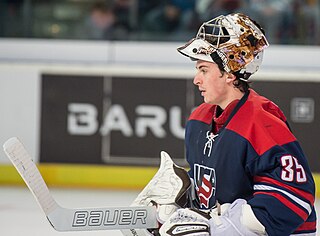
David Leggio is an American former professional ice hockey goaltender. Leggio spent most of his playing career in the American Hockey League.
In ice hockey, an awarded goal is an unusual situation in which a goal is awarded to a team rather than scored. A penalty shot is a type of penalty awarded when a team loses a clear scoring opportunity on a breakaway because of a foul committed by an opposing player. The fouled player is given an attempt to score a goal without opposition from any defending players except the goaltender ("goalie"). However, when such a lost opportunity occurs and the opposing team has pulled its goalie to substitute an extra attacker, a goal is simply awarded without a penalty shot taking place. The assumption is that, if not for the foul, the goal would have been scored.
The 2014–15 AHL season was the 79th season of the American Hockey League. The regular season began in October 2014 and ended in April 2015. The 2015 Calder Cup playoffs followed the conclusion of the regular season.
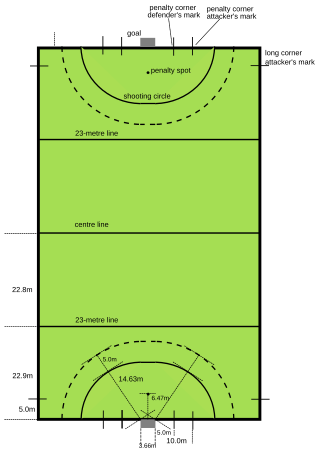
A hockey pitch is the playing surface for the game of field hockey. Historically, the game was played on natural turf (grass) and nowadays it is predominantly played on an artificial turf. The transition to artificial pitches came during the 1970s and was made mandatory for major competitions in 1976. All the lines, markings and goal specifications are outlined by the International Hockey Federation in "The Rules of Hockey".

In field hockey, a penalty stroke, sometimes known as a penalty flick, is the most severe penalty given. It is predominantly awarded when a foul has prevented a certain goal from being scored or for a deliberate infringement by a defender in the penalty circle.
The 2017–18 Deutsche Eishockey Liga season was the 24th season since the founding of the Deutsche Eishockey Liga.
Patrik Sigurður Gunnarsson is an Icelandic professional footballer who plays as a goalkeeper for Viking.
